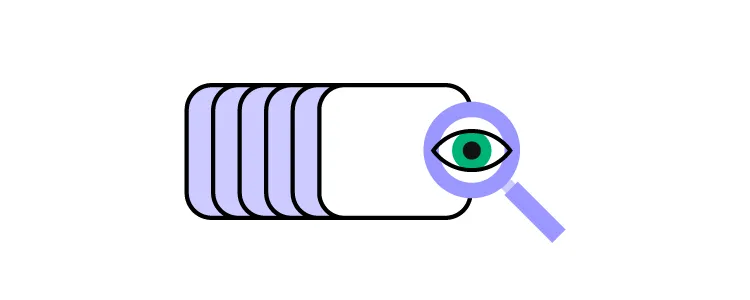How to Use Enterprise Design Thinking to Scale Design?

Enterprise design thinking was invented by IBM to compensate for the disconnect that enterprises often experience between teams, stakeholders, and end-users. It takes IDEO’s traditional design thinking methodology and changes it in a way to tackle the unique challenges of enterprise-level projects.
IBM’s Enterprise design thinking methodology has one major benefit. It prioritizes human connections throughout the entire process. In the end, designers get unique user insights that they cannot get from the traditional empathizing methodology.
One of the biggest challenges for large organizations is maintaining a human connection and relationship with their customers. Many companies make the mistake of investing heavily in technology and innovation without stopping to ask, “Does this solve a human problem?” or, “Is this product/feature desirable? Will people want it?”
When organizations lose touch with their customers, they prioritize innovation that fails to meet desirability–a core principle of design thinking.
Apple learned this the hard way with the Apple Newton, a personal assistant device (PDA) the tech giant launched and discontinued in the 90s. Although the PDA was incredibly innovative for its time, it was too expensive, didn’t perform well, and customers saw no purpose for a bulky handheld device four times the size of today’s iPhone 13.
There are many examples of corporations that failed to apply proper research and design thinking to prototype and test products effectively. Enterprise design thinking aims to solve this disconnect by developing a human-centered mindset that extends beyond the UX department so that teams can empathize with customers to solve real-world problems.
One way to improve inter-departmental collaboration and usability testing is by adopting the right design tool. UXPin is a code-based design tool built to enhance communication and collaboration between departments and stakeholders so organizations can design, test, and iterate faster.
When paired with UXPin’s Merge technology, enterprise design teams can create fully functioning prototypes and iterate faster. Discover UXPin Merge.
What is Enterprise Design Thinking?
Enterprise design thinking is a framework that re-envisions the traditional design thinking model more relevant to modern enterprises. Developed by IBM, “Enterprise Design Thinking is a human-centered framework to solve our users’ problems at the speed and scale of the modern enterprise.”
Framework Principles for Enterprise Design Thinking
IBM uses three core principles to guide its Enterprise Design Thinking framework:
- Focus on user outcomes: Drive business by helping users achieve their goals.
- Relentless reinvention: Stay essential by treating everything as a prototype.
- Diverse Empowerment Teams: Move faster by empowering diverse teams to act.
The Loop of Thinking and Innovation
Enterprise Design Thinking replaces the five stages of the design thinking process (empathize, define, ideate, prototype, test) with an iterative loop for designing and prototyping:
- Observe: Immerse yourself in the real world
- Reflect: Come together and look within
- Make: Give concrete form to abstract ideas
Team Alignment
Lastly, Enterprise Design Thinking uses a scalable framework to align teams towards a common human-centered purpose:
- Hills: Align teams on meaningful user outcomes to achieve
- Playbacks: Stay aligned by regularly exchanging feedback
- Sponsor Users: Invite expert users into the work to stay true to real-world needs.
How Can Enterprise Design Thinking Help Organizations?

At its core, Enterprise Design Thinking aims to solve two significant corporate challenges:
- Inviting customers into the design process to ensure ideas and innovation stay relevant to solving real-world problems.
- Breaking down silos between teams, departments, and stakeholders by making collaboration part of the design thinking process.
Focused on User Outcomes With a Real-World Problem to Solve
The Keys of Enterprise Design Thinking focus heavily on user outcomes and solving problems with diverse teams. It starts with a Hill–a technique similar to a problem statement for empathizing with users to create a meaningful outcome or goal for teams to focus on.
Teams use three elements to create a Hill statement:
- Who: The user persona. Who are you are designing for? The Who must be as specific as possible to create a human connection.
- What: What are you trying to solve? The user’s need becomes the project’s goal.
- Wow: Your unique selling point. How is your product different from the competition?
As long as the Hill includes these three elements, it doesn’t matter what order they’re in.
Using an example from IBM: “It should take no more than 30 minutes (Wow) for a developer (Who) to build and run an app using IBM and 3rd party APIs (What).”
With a Hill defined, teams have a clear objective to accomplish. This statement prioritizes a human problem over designing features or technological innovation. Instead, solving the problem becomes innovation.
Encourages Collaboration With Stakeholders and Teams
Traditional design thinking doesn’t consider collaboration and stakeholder involvement as a priority. In IBM’s Enterprise Design Thinking, Playbacks bring stakeholders into The Loop to align the organization’s goals with user goals.
In large organizations, it’s not uncommon for stakeholders and project teams to be misaligned, causing friction and frustration. Project teams think that stakeholders are out of touch, while stakeholders worry that the project is heading off-course or doesn’t align with the organization’s goals.
Playbacks encourage stakeholders to meet with team members regularly, share stories about the bigger picture, and exchange project feedback. The goal is to break down disruptive silos and eliminate the “us vs. them” (between teams, departments, and stakeholders) mentality many enterprises experience.
Improves Empathy With Reality
Enterprise design often involves designing products for highly skilled professionals or large organizations, like space agencies, medical institutions, government entities, large-scale production, and other industries.
It’s nearly impossible for designers to empathize with these users because they have no context or real-world experience of these complex work conditions, resulting in design solutions that make no sense to the end-users.
Enterprise Design Thinking adds Sponsor Users (industry experts) into the design loop, so designers go beyond empathizing and learn from real-world users with domain expertise. The goal is to find an expert who has a vested interest in the product succeeding. You also want someone who can be there throughout the design process, from concept to final product.
IBM vs. IDEO Design Thinking Methodology
Although there is nothing intrinsically wrong with IDEO’s design thinking, IBM needed a methodology that addressed unique enterprise challenges:
- Breaking down silos with diverse team collaboration
- Involving stakeholders in the design process
- Adding domain experts to help develop design solutions
- Managing with the scale and obscure challenges of enterprise-level projects
How to Apply Enterprise Design Thinking and Scale Design

In the free eBook Scaling Design Thinking in the Enterprise, author Julie Baher, Senior UX Director at Illumina, outlines a three-step process. While Julie’s process differs slightly from IBM’s approach, the underlying concept is the same–breaking down silos and including stakeholders in the design thinking process.
- Step One–Recruit Your Core Supporters: Engage with stakeholders to educate them about design thinking to understand UX workflows and get buy-in.
- Step Two–Converting the Organization: Use formal and informal events to scale design thinking across the organization.
- Step 3–Following Through With Lean Startup: Using goals defined during design thinking exercises, start the iterative process of prototyping and testing.
Our free 55-page eBook dives deeper into these three topics to help you develop a framework to scale design thinking within your organization. Download your free copy of Scaling Design Thinking in the Enterprise.
How PayPal Scaled Design Using UXPin Merge
With only three designers to over a thousand developers and more than 100 products, PayPal’s Erica Rider, UX design lead for developer tools, had a serious challenge–how could she scale design without scaling the design team?
PayPal’s also had four major issues affecting the design process:
- Inconsistent UI and design system usage
- Departmental silos that prevent rapid prototyping
- Poor communication between departments–particularly UX, product, and engineers
- Little input and feedback from stakeholders during the design process
After testing several ideas using image-based design tools, Erica discovered UXPin Merge–a code-based design tool that syncs code components from a repository to UXPin’s design editor.
Product designers (without little knowledge of UX or how to use design tools) drag and drop these code components to build high-fidelity prototypes that look and function like the final product.
Better still, PayPal’s “novice” product designers built these fully functioning prototypes eight times faster than experienced UX designers using image-based design tools.
PayPal also achieved other benefits from UXPin Merge that align with Enterprise Design Thinking methodology:
- Better collaboration and communication between UX, product, and development teams.
- More involvement from stakeholders who interact with fully functioning prototypes and provide feedback on UIs using UXPin’s Comments.
- Faster time-to-market with less coding to develop the final product.
- A single source of truth with design teams and developers using the same design system components hosted in a company repo.
- Meaningful feedback from usability participants because they can interact with fully functioning prototypes.
Learn how PayPal used UXPin Merge as the catalyst for a rapid development process to scale products for one of the world’s biggest FinTech organizations.
Summary
Enterprise design thinking adapts IDEO’s traditional design thinking methodology to cater to the unique challenges of enterprise-level projects.
To compensate for the disconnect enterprises often experience between teams, stakeholders, and customers, IBM’s Enterprise Design Thinking methodology prioritizes people and human connections throughout the process.
The result is an end-to-end design thinking process that encourages stakeholders to engage with teams and share stories that give team members a sense of purpose while aligning projects with business goals. By including domain experts, designers get unique user insights that they cannot get from the traditional empathizing methodology.
To get enterprise-level results, you need a design tool that provides enterprise-level solutions for collaboration, speed, and scale. As we saw with PayPal, UXPin Merge successfully bridges the gap between design and development while bringing stakeholders into the design process.
With UXPin Merge’s fully functioning prototypes, designers can follow IBM’s Enterprise Design Thinking Loop of observing, reflecting, and making to iterate solutions and design better customer experiences.
Learn more about UXPin Merge, the front-end frameworks we support, and how you can sign up to request access and join the code-based design revolution.




